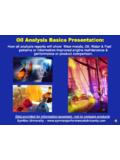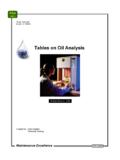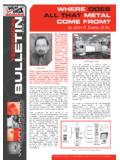Transcription of Institutional Analysis and Development: Elements of The ...
1 UNESCO EOLSSSAMPLE CHAPTERSHISTORICAL DEVELOPMENTS AND THEORETICAL APPROACHES IN SOCIOLOGY Vol. II - Institutional Analysis and Development: Elements of The Framework in Historical Perspective - Elinor Ostrom Encyclopedia of Life Support Systems (EOLSS) Institutional Analysis AND DEVELOPMENT: Elements OF THE FRAMEWORK IN HISTORICAL PERSPECTIVE Elinor Ostrom Workshop in Political Theory and Policy Analysis , Indiana University, USA Keywords: Actor, common-pool resources, configurations, institution, level of Analysis , norms, open-access, organization, property rights, public good, rules, strategies Contents 1.
2 Introduction 2. Challenges 3. Multiple Definitions of Institutions 4. Invisibility of Institutions 5. Multiple Disciplines Multiple Languages 6. Multiple Levels of Analysis 7. Configural Relationships 8. Institutional Framewor ks, Theories, and Models 9. The Institutional Analysis and Development Framework 10. Diagnosis and Explanation within the Frame of an Action Arena 11. An Action Situation 12. The Actor: Theories and Models of The Individual 13. Predicting Outcomes within an Action Arena 14. Evaluating Outcomes 15. Explanation: Viewing Action Arenas as Dependent Variables 16. The Concept of Rules 17.
3 Rule Configurations 18. Attributes of States of the World: Physical and Material Conditions 19. Attributes of the Community 20. Linking Action Arenas 21. Multiple Levels of Analysis 22. Uses and Value of the IAD Framework Glossary Bibliography Biographical Sketch Summary The IAD framework is a general language for analyzing and testing hypotheses about behavior in diverse situations at multiple levels of Analysis and concerns analyses of how rules, physical and material conditions, and attributes of community affect the structure of action arenas, the incentives that individuals face, and the resulting outcomes.
4 A systematic exposition of this meta-language is provided. 1. Introduction In previous centuries, social theorists such as Locke, Montesquieu, Hume, Adam Smith, UNESCO EOLSSSAMPLE CHAPTERSHISTORICAL DEVELOPMENTS AND THEORETICAL APPROACHES IN SOCIOLOGY Vol. II - Institutional Analysis and Development: Elements of The Framework in Historical Perspective - Elinor Ostrom Encyclopedia of Life Support Systems (EOLSS) Hamilton, Madison, and Tocqueville developed what in effect were Institutional analyses of their societies. Old or classical institutionalism was articulated from the turn of the nineteenth century on in the writings of John Dewey, Thorstein Veblen, John Commons.
5 More recently, this work has been further extended by a wide range of writers including Donald Davidson, Richard Rorty, Amartya Sen, Donald McCloskey, Warren Samuels, Philip Selznick, Daniel Bromley, EJ Mishan, Yngve Ramstad, and others. Over the last few decades, there has been a particularly strong development of Institutional Analysis (sometimes differentiated by the term neo- Institutional Analysis ) across a wide range of approaches. The new Institutional economics tradition is based on the work of Douglass C. North, Oliver Williamson, and others. In sociology, current Institutional Analysis has been summarized in volumes by Mary Brinton and Victor Nee and by Paul Di Maggio and Walter Powell.
6 The importance of culture and symbolism is given much greater emphasis in Institutional Analysis than will be found in more standard (and especially economic) analyses of organizations and behaviors. The Elements involved in these frameworks are closely related to concepts that have been developed in the work on Institutional Analysis and Development (IAD) which has been developed over several decades alongside the applying of these analytical tools to a wide array of empirical examples. Proponents of the older institutionalism sought explanations for Institutional change in terms of social and political volitions and often are opposed to the new institutionalism s explanation of Institutional change using rational choice theory or some variant of this.
7 To illustrate the wider frameworks of Institutional Analysis , this chapter focuses on IAD. 2. Challenges To begin, some of the difficulties that confront those interested in understanding incentives, institutions, and outcomes need to be indicated. Various aspects of the IAD approach are clarified if one is aware of the difficulties to be overcome in undertaking any form of Institutional Analysis . Here is an initial list of what is considered to be the key difficulties involved in studying institutions: 1. The term institution refers to many different types of entities, including both organizations and the rules used to structure patterns of interaction within and across organizations.
8 2. Although the buildings in which organized entities are located are quite visible, institutions themselves are invisible. 3. To develop a coherent approach to studying diverse types of Institutional arrangements, including markets, hierarchies, firms, families, voluntary associations, national governments, and international regimes, one needs multiple inputs from diverse disciplines. 4. Given the multiple languages used across disciplines, a coherent Institutional framework is needed to allow for expression and comparison of diverse theories and models of theories applied to particular puzzles and problem settings.
9 5. Decisions made about rules at any one level are usually made within a structure of rules existing at a different level. Thus, Institutional studies need to encompass multiple levels of Analysis . 6. At any one level of Analysis , combinations of rules, attributes of the world, and UNESCO EOLSSSAMPLE CHAPTERSHISTORICAL DEVELOPMENTS AND THEORETICAL APPROACHES IN SOCIOLOGY Vol. II - Institutional Analysis and Development: Elements of The Framework in Historical Perspective - Elinor Ostrom Encyclopedia of Life Support Systems (EOLSS) communities of individuals involved are combined in a configural rather than an additive manner.
10 These issues will be briefly discussed before turning to the IAD approach. 3. Multiple Definitions of Institutions It is hard to make much progress in the study of institutions if scholars define the term institution as meaning almost anything. A major confusion exists between scholars who use the term to refer to an organizational entity such as the Congress, a business firm, a political party, or a family and scholars who use the term to refer to the rules, norms, and strategies adopted by individuals operating within or across organizations. In this chapter, the term institution is used in the latter sense, to refer to the shared concepts used by humans in repetitive situations organized by rules, norms, and strategies.
















